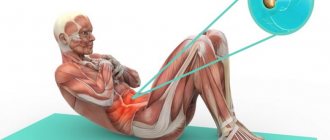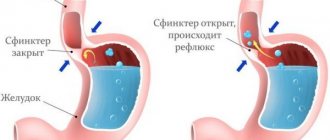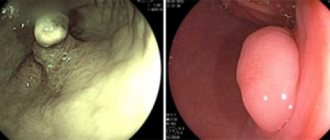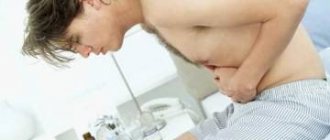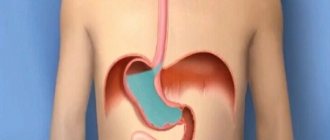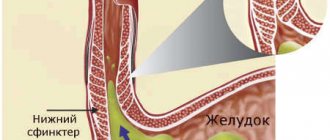Basic exercises for reflux esophagitis
When treating reflux esophagitis, special physical exercises are often prescribed, which should be combined with breathing exercises. This is the so-called aerobic training.
Typically this is not vigorous running or walking outdoors.
You should not eat before these exercises, as they relax the muscular system, so it is best to exercise in the morning, thereby preparing the body for food intake.
If you have been advised to engage in recreational walking, you should do it for one hour. Instead of regular walking, if the patient’s health allows, Scandinavian walking with ski poles is sometimes prescribed. At the same time, the load on the body increases significantly.
If your doctor has prescribed you to run, then you should do it for twenty minutes. It is not necessary to run fast; a light jog is enough.
In addition, you can additionally ride a bike and swim. It also improves abdominal tone.
While performing the exercises, try to avoid sudden bending of the body and strength exercises. If you experience heartburn during exercise, you should immediately stop exercising and reduce your load in the future.
Types of disorders and diseases
Rules for playing sports with reflux esophagitis
Among the patients of the gastrointestinal ward there are many people who are passionate about sports. How is reflux esophagitis combined with sports?
We hasten to reassure and please everyone who is concerned about this issue. Sport is not only useful, but also vital, since it is an integral part of the healing process. Of course, it is unfortunately impossible to get rid of reflux esophagitis by physical exercise alone, however, coupled with therapeutic nutrition and drug therapy, feasible exercise contributes to a speedy recovery.
Many gastroenterologists note that among people who devote a certain amount of time to physical activity every day and lead an active lifestyle, there are significantly fewer people suffering from gastroesophageal reflux disease than among those whose route runs from the sofa to the refrigerator and back. Extra pounds are another reliable way to get acquainted with reflux esophagitis. People whose BMI exceeds 30 are much more likely to join the ranks of gastroenterologist patients than those whose body mass index barely reaches 25.
But don’t think that any exercise helps with GERD. To ensure that playing sports does not cause you harm, you must first take care of drawing up a training plan that would take into account not only how severe the disease is, but also the level of physical fitness of the patient.
You should always remember that significant physical activity is strictly contraindicated for this disease. In order not to harm your health, you must adhere to the recommendations of a gastroenterologist and strictly follow a number of important rules:
When creating a menu for the week, focus on your training schedule. The consumption of some foods (primarily fatty foods and dishes made from legumes) with reflux esophagitis is strictly prohibited, while others (meat or fish) require quite a long time to digest. Therefore, if you have to start sports exercises soon after breakfast or lunch (no earlier than two hours!), It is better to eat a carbohydrate dish that is easily digested and does not contain a large amount of proteins and fats). In addition, it is necessary to refrain from eating foods that can cause heartburn and severe belching.
If possible, choose a time for training before meals. Physical exercise on a full stomach already places too much strain on the esophageal sphincter, but if strength loads, jumping, squats and bends are added to it, deterioration in well-being cannot be avoided.
Avoid doing exercises that are supposed to be done while lying down (such as bench presses). They can become a provoking factor for an attack of reflux.
You should not get involved in aerobics, fast running or crossfit. These exercises are too intense for those who suffer from reflux esophagitis. In addition, their implementation is associated with shaking of the body and, accordingly, the contents of the stomach, which means the inevitable appearance of a feeling of discomfort. The best sport for those who suffer from gastroesophageal reflux disease is one in which the body maintains an even position. This could be yoga, cycling, or ice skating. In this case, a home exercise bike will be an excellent help.
Don't forget about water! It not only quenches the legitimate thirst that arises after physical exertion, but also promotes normal digestion, not to mention how important it is for stabilizing the functional state of the organs of the human body.
Causes and symptoms of cardia failure
Before understanding the features of treatment, I would like to pay special attention to what are the causes and symptoms of esophageal cardia insufficiency. The main factor is poor nutrition; we should also not forget about drinking carbonated drinks in significant quantities, strong tea, alcoholic beverages and coffee. Other no less significant provoking factors should be considered a passive lifestyle (especially physically), excessive body weight, and other stomach diseases - gastritis, ulcerative lesions. The next reason for the need for exercise in case of insufficiency of the esophageal cardia, experts call increased pressure levels inside the peritoneum.
The symptoms of this pathological condition should be given much more attention, because this list includes constantly recurring heartburn.
Its characteristic feature is its formation regardless of the sessions of eating food. Other symptoms of the disease include:
Additional symptoms indicating that it is necessary to begin treatment are decreased ability to work and general fatigue. The objectives of exercise therapy, the peculiarities of its implementation and breathing exercises deserve special attention.
Healthy lifestyle with GERD
Gastroenterologists, when communicating with patients suffering from reflux esophagitis, pay special attention to lifestyle changes. Many patients are perplexed: can certain clothes, an evening walk, or a work schedule adjusted in accordance with the new condition really help?! Well, perhaps this seems funny or, at least, frivolous, however, only in this way, and in no other way, can such a problem be dealt with.
What changes should you prepare for?
- First, stop aimlessly lying on the couch with a laptop on your beer belly and a hot dog in your hand. Ideally, it would be nice to get rid of all these items at once, but, at worst, you will have to limit yourself to only food. You should have only easily digestible healthy food on your plate that does not irritate the mucous membrane of the digestive tract. After eating, do not rush to lie down for long hours, switching TV channels - take a half-hour walk (at a calm, slow pace) along a park alley or just along a quiet street.
- Secondly, after eating, do not rush to rearrange the cabinets and look for a new place for the piano. You can lift weights and engage in significant physical activity only after an hour and a half rest, even if you only ate half a banana before that.
- Thirdly, learn to eat slowly and thoughtfully, chewing food until liquid and under no circumstances swallowing large pieces. Try to plan your day so that you have time for five or six meals a day.
The disease will recede if you find the strength to say goodbye to smoking and extra pounds.
You should pay great attention to your clothes: they must be spacious, made only from natural fabrics, and not restrict movement. And, of course, no belts!
And, of course, strengthen your nervous system. Learn to think positively and find positive aspects in any event, even the saddest one. Do you think this is unrealistic? Read the wonderful novel “Pollyanna” by American writer Elinor Porter. Perhaps it will help you reconsider your outlook on life.
How to strengthen the sphincter between the stomach and esophagus
Exercises for reflux esophagitis are selected individually. It is advisable to attend several training sessions with a certified instructor. This approach will help avoid injuries during exercise.
Physical exercises for esophagitis are performed under the supervision of an instructor. It is important to do gymnastics on an empty stomach.
Gymnastics complex for GERD:
- Sitting on the floor, lean forward and bend your knees. Exhaling, press your fingers on the subcostal area. With each exhalation, plunge your fingers deeper and deeper.
- Standing straight with a straight back, bend to the right and left, sliding your hands on your hips.
- Lying on your back, bend your knees. Reach your elbow to the opposite knee and vice versa.
- To strengthen the lower sphincter, you need to lie on your right side on an inclined surface and raise your left leg at an angle of 45°. Repeat on the opposite side.
- Standing straight, perform sharp circular movements with your arms. Swings develop the upper shoulder girdle well and also create negative pressure in the pleural cavity.
Breathing breaks are 1-3 minutes. The complex must be repeated 2-3 times. Focus on your well-being.
Dynamic movements with body displacement in the vertical plane are contraindicated in patients with GERD. The best choice for cardio exercise would be an exercise bike.
During exercise on an exercise bike, the heartbeat and breathing increase, the organs are saturated with oxygen, and the activity of oxidative processes is inhibited. Improvements in esophageal motility are observed after 2-3 workouts.
In cases of severe symptoms of gastroesophageal reflux, aerobic exercise is contraindicated. This measure is necessary to prevent peptic esophagitis.
Breathing exercises for reflux esophagitis - optimal physical activity. But it must be done correctly.
Before starting classes, you should warm up. The lungs take an active part in this complex, so it is necessary to do 5-7 complete acts of breathing. Deep breathing straightens all the alveoli, forcing the lungs to work at full capacity.
Respiratory complex against esophagitis:
- Lie on your right side. Rest your head on your arm, bent at the elbow joint. Take a deep breath, then exhale with maximum force. Repeat 10-12 times. Repeat the cycle on the opposite side.
- Get on your knees. At the height of inhalation, bend the spine. Exhale. Repeat 8-10 times.
- Lie on your back. As you inhale as much as possible, rotate your pelvis. Make 10 turns on each side.
You should do breathing exercises regularly, not skip a day, always on an empty stomach and not forgetting the warm-up.
All exercises from the complex are performed at the height of inspiration:
All parts of Strelnikova’s breathing exercises are repeated 96 times. You can do 4, 8, 16 or 32 times. However, the total should be 96.
Breathing is the most important component of training. Ideal to practice with a partner.
Lie on your back, bend your knees. Find a point above and to the right 3 cm from the navel. As you inhale, hold your breath for 5-8 seconds. Make circular massaging movements. As you exhale, inflate your stomach. Repeat 8-10 times.
You should massage your stomach in a clockwise direction. Mechanical compression empties the gallbladder well, improves digestive processes, and relieves pain and bloating.
The peculiarity of the procedure is to perform it only on an empty stomach.
Yoga is an ancient Eastern teaching. Currently, some asanas (yoga poses) are used for therapeutic purposes.
Yoga requires complete control of breathing. When performed correctly, gymnastics strengthens the abdominal press, diaphragm and esophageal ligaments. The ancient practice is used in the East as monotherapy (the only treatment) for GERD and esophagitis. After exercise, pain goes away, blood circulation and digestion are normalized.
There will be no harm from yoga for esophagitis if you follow the instructor’s recommendations and do not overexert yourself.
Nutrition for reflux esophagitis
In addition to sports activities for reflux esophagitis, it is extremely important to organize proper nutrition. It should be fractional, portions should be small, and the food should undergo special heat treatment. Why is this necessary?
With reflux esophagitis (especially during the acute period), it is not easy for the human body to perform some basic functions, such as digesting food entering the stomach. If you continue to eat fatty borscht, goulash and fried potatoes, generously pouring ketchup and chili on it, complete digestion will not happen, and you will pay for such neglect of your health with heartburn, heaviness and stomach pain.
Small portion sizes allow food to be processed faster and easier.
Preference should be given to food that is steamed, stewed, baked or simply boiled in water. It is digested much faster, without irritating the inflamed mucous membrane of the esophagus.
Take your time! Food won’t run away from your plate, you’re not in the Stone Age! Eat calmly, admiring the scenery outside the window and thinking about something pleasant. Positive emotions contribute to the normalization of the gastrointestinal tract no less than medications.
What loads are contraindicated?
Exercising with esophagitis is useful and healthy. However, it is necessary to know which loads are incompatible with esophagitis.
It is useful to do pull-ups on horizontal bars and do push-ups on uneven bars. Bodyweight training strengthens the diaphragmatic muscles and ligaments.
- Only patients with healthy sphincters pump their abs. Abdominal training causes a sharp increase in pressure in the abdomen. After such exercises, 9 out of 10 patients complain of exacerbation of esophagitis.
- Limiting free weight for training. Do not lift or bend over weights. Weight training helps relax the diaphragm muscles, as well as increase intraperitoneal pressure.
- Dynamic aerobics is allowed only during the period of complete remission. If the sphincters fail, active movements provoke acid reflux, aggravating the course of esophagitis.
For reflux esophagitis, therapeutic exercises are indicated, as well as non-intensive training without weights.
Workouts for GERD
When training with reflux esophagitis, you need to be very careful and not overdo it. Never lift heavy weights or do excessive exercise.
Small physical activities are useful for GERD, however, if they are performed without measures, neglecting basic safety rules, a rupture of the wall at the site of the esophageal lesion may occur. This happens because the mucous membranes in this place are damaged. After this, you don’t even have to think about treatment at home: the patient is immediately hospitalized and undergoes surgical intervention.
If you feel reflux coming on during exercise, you should stop exercising immediately: hydrochloric acid can enter the trachea or bronchi and damage them, after which the patient will most likely be hospitalized.
Gymnastics and exercise therapy
Benefits of physical therapy
Exercise therapy should be prescribed by a doctor, since such activity is differentiated depending on the degree of the disease and the physical capabilities of each individual patient. If a patient has complicated or advanced reflux esophagitis, physical activity is completely contraindicated for him. The advantages of physical therapy are the following factors:
- such exercises improve muscle tone, which improves metabolic processes and promotes tissue regeneration;
- Exercise therapy improves the functioning of the human immune system;
- proper activity helps strengthen the diaphragm, which improves the functioning of the esophageal sphincter;
- Exercise therapy is used as a preventive measure against GERD;
- The right exercises can help get rid of night pain and burning.
Exercise therapy refers to physiotherapeutic treatment, so the complex is different for each patient. It is aimed at achieving specific goals:
- strengthen the immune system;
- develop the muscle layer, which will improve metabolic processes;
- heartburn prevention;
- improved absorption of medications.
Return to contents
Breathing exercises
In order for physical therapy for reflux esophagitis to bring maximum benefit, you need to learn how to breathe correctly. To do this you need to do breathing exercises. Before class, you need to find the most comfortable body position, it is best to stand or sit. You need to inhale deeply and exhale slowly. Repeat 4 times. You need to train on an empty stomach. If the patient has a severe degree of illness, he should refuse the procedures.
Such training should be done with breaks for rest, as physical exercise can cause fainting or weakness. You need to train for preventive purposes three times a week. In addition, you need to engage in other activities. Swimming and cardio exercises are useful for reflux esophagitis.
Swimming for reflux esophagitis
There is one simple way to improve abdominal tone: swimming. Many doctors recommend this sport to quickly recover from reflux esophagitis.
Why is swimming so beneficial? Precisely because, due to the difference in environmental pressure (and water, as you know, is much denser than air and, accordingly, presses harder), all the muscles of the abdominal cavity tense, trying to balance the environmental pressure with the pressure inside the body. This is the tonic property of swimming. With good muscle tone, it will be easier for you to fight the symptoms of reflux and recovery will go much faster.
However, you should remember that you are still unwell and you could feel ill at any moment. It is best to practice swimming in a shallow pool, which is guarded by a lifeguard team. If you feel yourself starting to lose consciousness or choke on vomit, try to relax so you can stay afloat. Signal to the rescuers to help you out of the water.
Main tasks of exercise therapy
Experts call the leading tasks of exercise therapy, first of all, the stabilization of the motor function of not only the stomach, but also the intestines.
In addition, this is how the fight against progressive flatulence is ensured. The next task of exercise therapy for achalasia of the esophageal cardia is to increase the contractile abilities of the lower esophageal sphincter. As is known, the legs of the diaphragm directly take part in the formation of the latter, which also need to be trained. The next task is to increase the strength and strength of the diaphragm. This is what will allow a person to count on the correct functioning of the esophagus, and therefore the entire digestive system. However, in order to achieve the presented goals, it is strongly recommended not to forget about all the features of the implementation of exercise therapy.
Breathing exercises for GERD
Diaphragmatic breathing
This procedure is based on breathing not from the chest, but from the stomach. Thanks to this, muscles are strengthened and the functioning of all internal organs without exception is improved. This type of breathing exercises is most popular for reflux esophagitis.
There are three exercises that need to be performed in turn:
- First exercise. Starting position: lying down with your knees bent. Place your left hand on your chest, your right hand on your stomach. Inhale air slowly, holding your chest from expanding, trying to direct all the air into your stomach. Do not prevent it from expanding, but, on the contrary, help it. Then also exhale slowly, while simultaneously returning to the starting position. Repeat the exercise thirty times, then rest for two to three minutes and repeat it thirty more times. Repeat the exercise three times a day.
- Second exercise. Starting position: sitting on a chair, hands on your knees. Also, inhale slowly, but do not hold your chest with your hands. Tighten your muscles, as if preventing your lungs from expanding too much with your ribs. If you do everything correctly, you will soon notice that your stomach protrudes when you inhale, and when you exhale, it falls, while your chest remains motionless. Typically, it takes patients about a week to master this exercise. This exercise should be done in the middle of the day, repeating thirty times.
- Third exercise. It is performed in exactly the same way as the second, but you need to inhale air not through your nose, but through loosely compressed lips. This exercise is one of the most difficult, so it is enough to repeat it only ten or twenty times.
Exercises for breathing problems resulting from GERD
If your trachea or bronchi are damaged as a result of gastroesophageal reflux disease, normal breathing techniques may harm you. Lightweight gymnastics have been specially developed for such patients.
- First exercise. Inhale through your nose while inflating your stomach. Then hold your breath for three seconds. Close your right nostril with your finger and exhale. Repeat the exercise thirty times, alternating nostrils.
- Second exercise. Before the exercise, pour some water into a dish with high sides. Inhale through your nose. Pull your lips out with a tube and dip them into the water. Release the air slowly. If this exercise seems too difficult for you, use a glass of water and a straw through which you slowly blow air.
Gymnastics Strelnikova
Most often, these exercises are performed either during rehabilitation, after an acute form of the disease, or in cases where nothing else helps.
The essence of the exercise is that you need to take thirty small breaths through your nose, with each of which you need to hug your shoulders with your hands, followed by one large exhalation through your mouth.
You can do the proposed exercise while standing, lying down or sitting. The first days it is enough to take up to four hundred breaths at a time, however, in the future you should try to bring this figure to a thousand.
Features of physiotherapy
Physiotherapeutic techniques such as DDT are effectively used, namely diadynamic currents, electrophoresis with certain medications, and also due to a probe embedded inside. It is necessary to understand that each of the presented methods will not directly affect the problem area of the esophagus, because it is extremely difficult to reach.
However, this is exactly how the phrenic nerve is stimulated, which will also innervate the esophagus. The electrodes through which the current is supplied must be applied to the area of the cervicothoracic spine at the back. While the second is behind the angle in the lower jaw area. In this way, from seven to 10 procedures are carried out every day or every other day.
Electrophoresis with drugs is carried out in a similar way, however, certain drugs are applied to the cuff with electrodes as an additional measure of influence. They are the ones who can inhibit excessive production of hydrochloric acid, which will gradually lead to calmer functioning of the esophagus.
According to experts, changes such as improved blood supply to tissue structures and internal organs are noted. In addition, we are talking about healing processes that will occur much faster. A person also notices a slight, but still noticeable analgesic effect.
HOW TO SIGNIFICANTLY REDUCE THE RISK OF CANCER?
TAKE THE FREE TEST! Thanks to detailed answers to all questions at the end of the test, you can REDUCE the likelihood of disease by several times!
Warsaw gymnastics for GERD is prescribed quite often. Therapeutic exercise only speeds up recovery, keeps the condition stable for a long time, and reduces the amount of medications consumed. However, it will not be possible to cure gastroesophageal disease with gymnastics alone, although the time of recovery will come closer.
Contraindications
In case of gastroesophageal reflux disease, exercises that must be performed lying down are strictly contraindicated, since in this position the contents of the stomach are thrown into the esophagus, greatly increasing the discomfort: belching, heartburn and sharp chest pain.
In addition, the following exercises are contraindicated for GERD:
- Tilts of the body forward and similar;
- Training with sports equipment weighing more than ten kilograms;
- Abdominal exercises - the most dangerous are those in which you need to raise your legs while lying down.
You need to perform any exercises for reflux esophagitis either standing or sitting on a chair, and in no case overexert yourself. This - with a sufficient amount of high-quality water without gas - helps to strengthen the digestive function.
Before engaging in any sport if you have reflux esophagitis, be sure to consult your doctor.
Symptoms of cardia failure
In gastroenterology, a distinction is made between the primary and secondary stages of this disease. Primary failure can be observed in infants, which resolves within two months. The following can lead to secondary failure:
- burns of the esophagus;
- poor nutrition;
- frequent overeating;
- sedentary, passive lifestyle leading to obesity;
- heaviness in the stomach due to eating before bed.
A pathology in which incomplete closure of the valve between the esophagus and stomach occurs has general and local symptoms. Depending on the stage and form of development, heartburn of a permanent or periodic nature may occur, nausea and vomiting may occur. A burning sensation in the area behind the sternum is typical. It is often possible to observe belching and a coating on the tongue in patients with this disease. The food eaten can cause an unpleasant sour taste in the mouth, as well as bad breath.
This pathology in most cases does not have a primary form and can develop against the background of diseases such as gastritis, esophagitis, hiatal hernia and other pathological manifestations of the digestive tract. When observed from the outside, demonstrative symptoms of this disease include weakness, decreased activity and irritability of the patient.
Reviews
Dear readers, your opinion is very important to us - therefore, we will be glad to receive feedback on breathing exercises for reflux esophagitis in the comments, this will also be useful to other users of the site.
Yana, Vitebsk
“Strelnikova’s gymnastics helps me very well with manifestations of reflux esophagitis. A few full-fledged exercises are enough to forget about unpleasant sensations for at least half a month.”
Lydia, Sevastopol
“While in the hospital for GERD, I began doing breathing exercises with my stomach - holding my chest with my palm, inhaling slowly, then holding my breath and exhaling even more slowly, drawing my stomach in deeply. It turned out to be a kind of massage of the internal organs. I started with literally two times (I couldn’t do it anymore because of the weight), and by the time I was discharged I could do more than twenty in one go. She continued her studies at home. The heartburn and pain became incomparably weaker, but that’s not all: after a month I discovered that I began to lose weight. Naturally, after that I began to study with tripled enthusiasm! Six months later, I lost 11 kilograms, and the reflux disappeared on its own - I couldn’t stand the test of joy.”
Gymnastics is not a cure
Before completely switching to this type of help, everyone should understand some important points for themselves:
- gymnastics does not relieve heartburn, this method only helps speed up the healing process or reduce the periods and number of exacerbations;
- there is no ideally developed exercise scheme, everyone can choose for themselves those that will subsequently provide real help to them;
- Gymnastics for GERD is a non-main method of treatment; without the combined use of medications and if the diet is not followed, the exercises will not be effective;
- There is no 100% guarantee that classes will have a positive effect on the process of getting rid of reflux disease; do not have any illusions about a happy, full recovery.
At the moment, there is no complex selected for each disease of the digestive system. These are most often general exercises that will not save you in an emergency situation, but they can alleviate the course of the disease.
How to treat?
The basic principles of treatment of extraesophageal manifestations of GERD are carried out in several directions: non-drug effects (normalization of lifestyle, diet), drug therapy, surgical correction.
Lifestyle changes include normalizing body weight, following a diet, and stopping smoking. It is very important to adjust the volume of food, the nature and time of its intake. It is necessary to convince the patient not to overeat, not to eat before bed, at night, not to lie down after eating for 1.5 hours. In case of severe esophagitis, split meals are recommended.
Wearing tight belts, corsets, and physical exercises with bending down is not recommended. It is recommended to raise the head end of the bed by 15–20 cm.
Drug therapy for GERD includes the use of antacids, prokinetics and antisecretory drugs.
Antacids are effective for rare symptoms of GER that occur when lifestyle recommendations are not followed. For the treatment of GERD, it is better to use liquid, non-absorbable aluminum and magnesium-containing antacids. These include: Almagel, Phosphalugel, Maalox, Gastal, Rennie, etc. They should be taken 1.5–2 hours after meals and at night.
Prokinetics (domperidone, metoclopramide) lead to restoration of the physiological state of the esophagus, promote increased motility and accelerated evacuation of gastric contents, and increase the tone of the lower esophageal sphincter.
The goal of antisecretory therapy for GERD is to reduce the damaging effect of acidic gastric reflux on the esophageal mucosa. Currently, the drugs of choice for the treatment of extraesophageal manifestations of GERD are PPIs (omeprazole, lansoprazole, pantoprazole, rabeprazole, esomeprazole), which block the formation of hydrochloric acid in the parietal cells of the stomach. It is considered proven that all patients with extraesophageal manifestations of GERD should be prescribed a high dose of PPI, and the duration of treatment should be at least 3 months. When symptoms are relieved, they switch to maintenance therapy for 6–12 months [1, 2, 3, 4].
Material tested by Aktion Medicine experts
Source: www.provrach.ru
